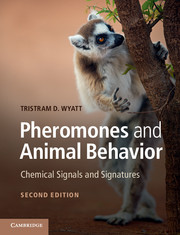Book contents
- Frontmatter
- Dedication
- Contents
- Preface to the second edition
- Acknowledgments
- List of SI prefixes
- List of Abbreviations
- 1 Animals in a chemical world
- 2 Methods for identifying and studying semiochemicals
- 3 Pheromones, chemical cues, and sexual selection
- 4 Coming together and keeping apart: aggregation pheromones and host-marking pheromones
- 5 Territorial behavior and semiochemicals
- 6 Semiochemicals and social organization
- 7 Pheromones and recruitment communication
- 8 Fight or flight: alarm pheromones and cues
- 9 Perception and response to chemical communication: from chemosensory receptors to brains, behavior, and development
- 10 Finding the source: pheromones and orientation behavior
- 11 Breaking the code: illicit signalers and receivers of semiochemicals
- 12 Using semiochemicals: applications of pheromones
- 13 On the scent of human attraction: human pheromones?
- Appendix An introduction to chemical terms for non-chemists
- References
- List of Credits
- Index
5 - Territorial behavior and semiochemicals
Published online by Cambridge University Press: 05 June 2014
- Frontmatter
- Dedication
- Contents
- Preface to the second edition
- Acknowledgments
- List of SI prefixes
- List of Abbreviations
- 1 Animals in a chemical world
- 2 Methods for identifying and studying semiochemicals
- 3 Pheromones, chemical cues, and sexual selection
- 4 Coming together and keeping apart: aggregation pheromones and host-marking pheromones
- 5 Territorial behavior and semiochemicals
- 6 Semiochemicals and social organization
- 7 Pheromones and recruitment communication
- 8 Fight or flight: alarm pheromones and cues
- 9 Perception and response to chemical communication: from chemosensory receptors to brains, behavior, and development
- 10 Finding the source: pheromones and orientation behavior
- 11 Breaking the code: illicit signalers and receivers of semiochemicals
- 12 Using semiochemicals: applications of pheromones
- 13 On the scent of human attraction: human pheromones?
- Appendix An introduction to chemical terms for non-chemists
- References
- List of Credits
- Index
Summary
Marking a territory with scent marks is a conspicuous behavior of many mammals and other terrestrial vertebrates including lizards (Font et al. 2012; Martín & López 2010a; Müller-Schwarze 2006; Roberts 2007). The molecules in scent marks include species-wide pheromones as well as highly individual odors, which are cues to identity (Chapter 1; Wyatt 2010).
Mammals have an enormous variety of specialized scent glands but a common pattern of scent marking: glandular secretions, and often feces and urine, are placed at conspicuous places in their home ranges or territories, often in lines along paths or boundaries (Figure 5.1) (Gosling & Roberts 2001). Males tend to mark more than females, and dominant males or territory holders mark most, especially during breeding (Roberts 2007). Scent marking may form a central part of ritualized contests between territorial males or between competing groups, for example “stink fights” between neighboring groups of ringtailed lemurs (Figure 5.2).
One benefit of scent marks for territorial behavior is that, unlike other signals, scent marks “shout” even when the animal is not there. However, while it may take less energy than sound signals (Chapter 1), scent marking in some species can have significant metabolic costs – in mice the territorial male’s urine marks contain 20 to 40 mg/ml of protein, largely MUPs (Box 5.2) (Hurst & Beynon 2004, 2013). Other costs are in time and risk. For example, males of a territorial African antelope, the oribi, Ourebia ourebi, spend up to 35% of their time on marking or associated activities (Brashares & Arcese 1999a). Animals will go to some risk to investigate and over-mark intruders’ scent marks. Beavers will leave the safety of water to investigate foreign scent marks on the shore (Sun & Müller-Schwarze 1998). Scent marks can be “eavesdropped” by predators and parasites (Chapter 11).
- Type
- Chapter
- Information
- Pheromones and Animal BehaviorChemical Signals and Signatures, pp. 113 - 125Publisher: Cambridge University PressPrint publication year: 2014



